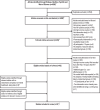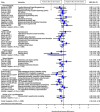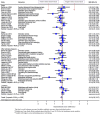Evidence from high-income countries on the effectiveness of psychosocial interventions to improve mental health, wellbeing and quality of life for adults living with HIV: a systematic review and meta-analysis
- PMID: 40141017
- PMCID: PMC11946541
- DOI: 10.1002/jia2.26424
Evidence from high-income countries on the effectiveness of psychosocial interventions to improve mental health, wellbeing and quality of life for adults living with HIV: a systematic review and meta-analysis
Abstract
Introduction: There is a need to synthesize recent evidence on the effectiveness of psychosocial interventions to improve mental health, quality of life and wellbeing in adults living with HIV in high-income countries. A systematic review and meta-analysis was conducted to address this research gap.
Methods: Medline, Embase, Psychinfo and Web of science were searched (from 2008 to December 2023). In total, 67 randomized controlled trials (RCTs) of psychosocial intervention among adults living with HIV in high-income countries were eligible.
Results: In the meta-analysis, there was an overall positive effect of interventions on reducing depression (N = 40; standardized mean difference [SMD] -0.19 [95% CI: -0.29, -0.10]), anxiety (N = 15; SMD -0.12 [-0.23, -0.02]), stress (N = 13; SMD -0.22 [-0.41, -0.04]), and other measures of poor wellbeing (N = 19; SMD -0.18 [-0.35, -0.02]) and increasing levels of coping/self-efficacy (N = 8; SMD 0.17 [0.04, 0.31]). For depression, interventions that used symptom screening above a threshold score to identify eligible individuals were more effective than those without such an eligibility criterion (SMD -0.29 vs. -0.10, p = 0.023). Interventions compared to standard care controls had a greater effect on depression versus interventions compared to not standard care controls, when the latter category included standard care controls that received intentional support (SMD -0.28 vs. -0.11, p = 0.035). There was also weak evidence of an overall positive effect on: reducing stigma (N = 7; SMD -0.17 [-0.35, 0.02]), and improving social support/participation (N = 6; SMD 0.17 [-0.02, 0.35]), mental health quality of life (N = 12; SMD 0.09 [-0.01, 0.19]), physical health quality of life (N = 11; SMD 0.07 [-0.02, 0.16]) and quality of social life (N = 6; SMD 0.10 [-0.04, 0.24]). There was no evidence found for an effect on loneliness, although data were limited.
Discussion: Pooled effect estimates were small or small tomoderate. In line with previous literature, there was no evidence of differential effects on depression according to the intervention type (psychotherapeutic vs. other).
Conclusions: Evidence from RCTs suggest that psychosocial interventions are effective in improving mental health for adults living with HIV in high-income settings. Interventions were more effective at reducing depression when targeted at those screening positive for mental health symptoms and when compared to a standard care only control group. There was some evidence that longer, more intensive interventions were more effective.
Keywords: HIV; RCT; anxiety; depression; intervention; psychosocial.
© 2025 The Author(s). Journal of the International AIDS Society published by John Wiley & Sons Ltd on behalf of the International AIDS Society.
Conflict of interest statement
No potential conflict of interest was reported by the authors.
Figures









References
-
- Colloty J, Teixeira M, Hunt R. Advances in the treatment and prevention of HIV: what you need to know. Br J Hosp Med (Lond). 2023;84(7):1–9. - PubMed
-
- Rodger AJ, Cambiano V, Bruun T, Vernazza P, Collins S, Degen O, et al. Risk of HIV transmission through condomless sex in serodifferent gay couples with the HIV‐positive partner taking suppressive antiretroviral therapy (PARTNER): final results of a multicentre, prospective, observational study. Lancet. 2019;393(10189):2428–2438. - PMC - PubMed
-
- Nkulu‐Kalengayi FK, Hurtig AK, Linander I. “Discrimination is harder to live with than the disease”: an interview study of the perceptions and experiences of sexual and reproductive health and rights among women living with HIV in Sweden. Sex Reprod Health Matters. 2023;31(1):2245197. - PMC - PubMed
Publication types
MeSH terms
Grants and funding
LinkOut - more resources
Full Text Sources
Medical
Miscellaneous

